Fire-Bellied Newts Care Sheet
Common names: There are two kinds of Fire-Bellied Newt that are readily available in the pet trade:
Japanese Fire-Bellied Newt: Cynops pyrrhogaster
Chinese Fire-Bellied Newt: Cynops Orientalis
The Chinese Fire-bellied Newt may sometimes also be referred to as the Oriental Fire-Bellied Newt or the Dwarf Fire-Bellied Newt.
Description
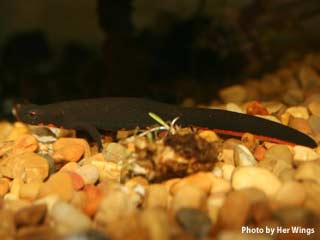 Description: Fire-Bellied Newts are usually dark brown to black with red or orange undersides, hence the name Fire-Bellied. The Japanese Fire-Bellied Newt is larger than the Chinese Fire-Bellied Newt and they tend to have red speckled bellies. They have rough skin, while the Chinese Fire-bellied Newts have smooth skin and a speckled orange underside.
Description: Fire-Bellied Newts are usually dark brown to black with red or orange undersides, hence the name Fire-Bellied. The Japanese Fire-Bellied Newt is larger than the Chinese Fire-Bellied Newt and they tend to have red speckled bellies. They have rough skin, while the Chinese Fire-bellied Newts have smooth skin and a speckled orange underside.
Size: Japanese Fire-Bellied Newts average at about 9-12 CM (3.5-5 inches), while Chinese Fire-Bellied Newts will only grow to 6-10 CM (3-4 inches).
Life span: Fire-Bellied Newts can live up to 30 years with appropriate care, but average at about 10-15 years generally.
Origin: Japanese Fire-Bellied Newts are native to Japan on the Islands of Honshu, Kyushu and Shikoku. The Chinese Fire-Bellied Newt is native to China.
Habitat: Fire-Bellied Newts live in slow moving streams and rivers and can also be found in ponds, lakes and ditches. They are largely aquatic, so spend the majority of their time in cool, still waters.
Things to consider before purchasing your first Amphibian
• Who will look after your new pet if you are away?
• Can you obtain its food easily from your local pet shop?
• Would you be comfortable feeding live insects as food?
• Are you comfortable having live food in the house to feed your pet?
• Is the rest of the family happy to live with an amphibian?
Captive Care
Temperament: Fire-Bellied Newts are a very active species of newt, so they make great pets. They are great first amphibians, because they are relatively easy to care for. They may be quite shy when they are first introduced to a new set up, but usually become more active when they become accustomed to their surroundings.
Fire-Bellied Newts can be housed together with other Fire-Bellied Newts, but be careful if you choose to co-habit them with other species. Fire-Bellied Newts secrete a toxin from their skin that can harm other inhabitants with prolonged exposure.
Housing: An Aquarium or glass terrarium will be needed to house your Fire-Bellied Newts.
Fire-Bellied Newts are semi-aquatic and need a 70/30 split within their tank, with 30% being land based, while the other being a water area. Alternatively, you could have a fully aquatic set-up, with floating islands of cork bark or large rocks pertruding out of the water to give your newts a place to rest and bask.
They are good at escaping, so care should be taken to ensure your tank has a tight fitting lid.
Your terrarium should contain:
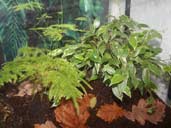 Substrate: A rocky slope may be all that is necessary for the land area of your terrarium, but if you would like to partition your tank, then you can fill the land side with a burrowing substrate like coco husk, sandy top soil or compost (without fertilisers), orchid bark chips, sphagnum moss, peat, live moss and a selection of live plants. (See plant list in the forum)
Substrate: A rocky slope may be all that is necessary for the land area of your terrarium, but if you would like to partition your tank, then you can fill the land side with a burrowing substrate like coco husk, sandy top soil or compost (without fertilisers), orchid bark chips, sphagnum moss, peat, live moss and a selection of live plants. (See plant list in the forum)
Gravel is a good under water substrate for the water side of your tank, which can also be decorated with aquatic or plastic aquarium plants.
Set-up tips can also be found on the forum.
Water: Most of the terrarium should be dedicated to providing adequate water for your Fire-Bellied Newts. The water should be at a depth of approximately 25CM (10 inch) and changed daily to avoid the build up of bacteria, unless a filter can be provided to keep the water clean. With a filter it should only be necessary to change one third of the water every week.
If you have a partition between the land and water area in your terrarium, a ramp or stones near the division will help your newts leave the water.
De-chlorinated or bottled spring water should always be used as Fire-Bellied Newts are really sensitive to various chemicals and cannot handle water with Chlorine and chlorimines in.
Fire-Bellied Newts like most amphibians will soak up water through their skin and since their water bowl is used as the main place to defecate it is important that it is cleaned regularly.
A place for your Fire-Bellied Newt to hide and climb
All amphibians require somewhere to hide and may become stressed if this is not provided. This could be a plant pot on its side, which is low cost but easily cleaned if it becomes soiled.
Logs, stones and cork bark make good natural looking additions to your terrarium and make great hiding places. Plants and moss are also greatly appreciated and can be placed in both the land and water areas.
Stones or branches from the wild need to be debugged by soaking first in sterilizing solution, and then rinsed thoroughly, soaked in clean water, then left to dry in the sun. Some live plants may be harmful to your Fire-Bellied Newt, if in doubt please see the list of safe plants which can be used in the forum.
A change of scenery
Fire-Bellied Newts are very inquisitive animals and like to explore new surroundings. Once in a while change the layout of the terrarium. This will keep your Fire-Bellied Newt from becoming bored. You will notice once you put your Fire-Bellied Newt back in the tank it will start to re-explore its new surroundings.
Humidity
If you have used a burrowing substrate in your land area, then this should be kept damp with regular misting with de-chlorinated water from a spray bottle. Care should be taken to ensure that this area does not become water logged.
Heat
The ideal temperature for your Fire-Bellied Newt is a temperature of around 17-21°C (around room temperature) with a slight temperature drop at night of 1 or 2 degrees.
As Fire-Bellied Newts are kept at around room temperature it should not be necessary to provide extra heat, but if the temperature in the tank falls too low you can use an under tank heat mat or water heater to help raise temperatures. Both should be regulated by an appropriate thermostat to prevent the temperature getting too high, as Fire-Bellied Newts can become stressed if the temperature goes above 24°C. Heat mats should only cover between a third and a half of the floor/wall space to allow your Fire-Bellied Newt to thermo regulate.
Never use heat lamps or basking lamps for amphibians, as these can cause your Fire-Bellied Newts to dehydrate.
It's useful to have a small thermometer on either end of the terrarium to check the temperature. One end should be around 17°C and the other around 21°C to ensure that your Fire-Bellied Newt can thermo-regulate by moving around the tank.
Feeding
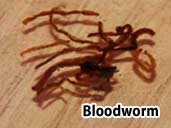 |
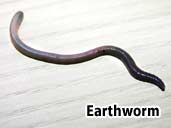 |
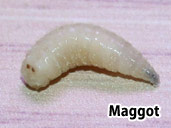 |
Fire-Bellied Newts should be fed 2-3 times a week with a varied diet of appropriately sized prey items, such as bloodworms (frozen or fresh), earthworms, maggots, Tubifex, shrimp, insect larvae and slugs. Feed 3 or 4 prey items per Fire-Bellied Newt per feeding.
Lighting
Fire-Bellied Newts should be kept out of direct sunlight, but with a 12/12 light cycle (12 hours light to 12 hours dark). Natural sunlight should suffice during the summer months, but a bulb may be required to keep this 12/12 cycle during the winter. Newts do not need additional UV, so a normal energy saving light bulb should be fine, although you may find that any live plants in your terrarium will die without any UV light. A fluorescent UVB tube is ideal as it won’t give out any heat and will help the plants thrive.
Cleaning
Your Fire-Bellied Newt’s terrarium should be inspected and spot cleaned daily. Every one to two weeks clean out the tank completely and sterilise using a reptile/amphibian friendly disinfectant. Sterilise any décor and carefully remove any live plants to replace when the tank has been cleaned. The water side of the tank also needs to be emptied, cleaned and refreshed with fresh de-chlorinated water.
Your Fire-Bellied Newts should be moved to a temporary tank whilst being cleaned and care must be taken to make sure no chemicals are used in the cleaning process, as these can harm your newts.
Handling
Fire-Bellied Newts have delicate skin and secrete a toxin from the poison glands on the side of their heads that can be an irritant to your skin. Regular handling is not recommended, but if it is necessary wear gloves. This will protect both you and your newts, who are sensitive to many chemicals that may be on your hands, such as washing up liquid, soap residue, hand cream etc.
When cleaning your terrarium you can safely remove your Fire-Bellied Newts to another tank using an aquarium net usually used for pet fish.
Sexing
Male Chinese Fire-Bellied Newts can be distinguished easily during the breeding season (March to July), as they develop a bluish sheen on their tails to attract a mate. Japanese Fire-bellied Newt males also develop this sheen, but it has a purple tint. At this time, females will also become swollen with eggs, so that identification of the female is also easily done.
Year round it is harder to determine sex, but generally females are fatter than the males when viewed from above and in the Japanese Fire-Bellied Newt the male is bigger than the female. Determining the sex of larvae and juvenile newts is almost impossible.
Breeding
Breeding Fire-Bellied Newts is quite simple, but not always successful. Conditions need to be right to encourage Fire-Bellied Newts to breed and they need to be cooled for around 50 days beforehand. Reduce both the temperature and the light during the cooling period and aim to keep them at around 10°C at this time. Reduce feeding to a minimum and only feed items that won’t spoil in the water if left by your newts.
After the cooling period, bring the temperatures back up to around 20°C and feed them well. This should replicate the conditions of spring and encourage your newts to begin courtship. Males release pheromones to attract the female and fertilization is internal.
Around 100 – 200 eggs will be spawned around the base of the aquatic plants. The adults should be separated from the spawn as soon as possible to avoid them eating the eggs. They will incubate for approximately 4-6 weeks before hatching.
The newly hatched larvae are fully aquatic can be fed on finely chopped earthworms of flaked fish food, until they metamorphose at around 4-6 months, depending on the water temperature. Juvenile fire-bellied newts live terrestrially (on land) for 1-3 years until they mature, then will return to the water to continue an aquatic lifestyle.
Other questions about the Fire-Bellied Newt
If you have any other questions why not join The Amphibian Forum and ask one of the many experienced keepers, the reason this website was set up was so people in the amphibian keeping hobby could share their experiences with others.

